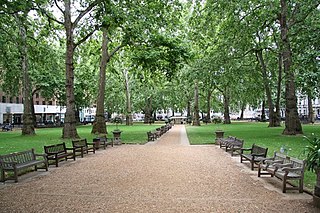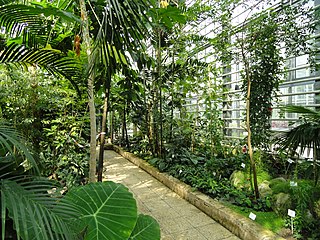
The Botanical Garden of the University of Vienna is a botanical garden in Vienna, Austria. It covers 8 hectares and is immediately adjacent to the Belvedere gardens. It is a part of the University of Vienna.

The Botanical Garden of the University of Vienna is a botanical garden in Vienna, Austria. It covers 8 hectares and is immediately adjacent to the Belvedere gardens. It is a part of the University of Vienna.
The gardens date back to 1754 when Empress Maria Theresa founded the Hortus Botanicus Vindobonensis with renowned botanist Nikolaus von Jacquin as one of its first directors. His son, Joseph von Jacquin, succeeded him as director, as did a number of other leading botanists in turn, including Stefan Endlicher, Eduard Fenzl, Anton Kerner von Marilaun, Richard von Wettstein, Fritz Knoll, Karl von Frisch, and Lothar Geitler. The Institute of Botany building was opened in 1905. However, at the end of the Second World War, the institute, all the greenhouses, and the entire garden area were bombed and severely damaged, and thus required major repair work.
In 1994, Wollemia ( Wollemia nobilis ) was discovered in Australia, previously known only from fossils. On the occasion of the 250th anniversary of the Botanical Garden of the University of Vienna in 2004, the garden received a Wollemia as a gift from Australia, this was the first Wollemia to be shown on the European mainland. This plant is now on permanent loan to the Schönbrunn Palm House. In the garden, the non-hardy plant is part of the cold house group. [1] On May 29, 2022, 2:30 p.m., the titanwort has reached "full bloom". The top heats up in the process and emits an unpleasant odor. The opening hours of the two following days are extended to 11 p.m. [2]
The gardens currently contain more than 11,500 species of plants, including well-documented tropical plants, particularly of such families as Annonaceae, Rubiaceae, Gesneriaceae, Bromeliaceae or Orchidaceae. [3] Its greenhouses (c. 1,500 m2) were originally built between 1890 and 1893, but were damaged during the Second World War; they were renovated or rebuilt between 1970 and 1995. Only the tropical greenhouse in the centre of the complex is open for the public.
There are several old trees in the Botanical Garden, but one of the oldest is now no longer on the garden grounds. The Jacquin or Mozart plane tree ( Platanus orientalis ) is a Viennese natural monument and grows in front of the Department of Botany and Biodiversity Research. Due to property shifts, it now stands on the sidewalk in front of the department.
The garden collections include:



A botanical garden or botanic garden is a garden with a documented collection of living plants for the purpose of scientific research, conservation, display, and education. It is their mandate as a botanical garden that plants are labelled with their botanical names. It may contain specialist plant collections such as cacti and other succulent plants, herb gardens, plants from particular parts of the world, and so on; there may be glasshouses or shadehouses, again with special collections such as tropical plants, alpine plants, or other exotic plants that don't grow natively within that region.

Wollemia is a genus of coniferous trees in the family Araucariaceae, endemic to Australia. It represents only one of three living genera in the family, alongside Araucaria and Agathis. The genus only has a single known species, Wollemia nobilis, which was discovered in 1994 in a temperate rainforest wilderness area of the Wollemi National Park in New South Wales. It was growing in a remote series of narrow, steep-sided, sandstone gorges 150 km (93 mi) north-west of Sydney. The genus is named after the National Park.

Platanus orientalis, the Old World sycamore or Oriental plane, is a large, deciduous tree of the Platanaceae family, growing to 30 m (98 ft) or more, and known for its longevity and spreading crown. In autumn its deep green leaves may change to blood red, amber, and yellow.

Platanus × acerifolia, Platanus × hispanica, or hybrid plane, is a tree in the genus Platanus. It is often known by the synonym London plane or London planetree. It is a hybrid of Platanus orientalis and Platanus occidentalis.

The Jardin des plantes, also known as the Jardin des plantes de Paris when distinguished from other jardins des plantes in other cities, is the main botanical garden in France. The term Jardin des plantes is the official name in the present day, but it is in fact an elliptical form of Jardin royal des plantes médicinales, which is related to the original purpose of the garden back in the 17th century.

Heinrich Wilhelm Schott was an Austrian botanist. He is known for his extensive work on aroids (Araceae).

Nikolaus Joseph Freiherr von Jacquin was a scientist who studied medicine, chemistry and botany.

Josef (Joseph) August Schultes was an Austrian botanist and professor from Vienna. Together with Johann Jacob Roemer (1763–1819), he published the 16th edition of Linnaeus' Systema Vegetabilium. In 1821, he was elected a foreign member of the Royal Swedish Academy of Sciences. He was the father of Julius Hermann Schultes (1804-1840).

The A.V. Fomin Botanical Garden is one of the oldest botanical gardens in Ukraine, located in Kyiv, the capital of Ukraine. In 1839 the Saint Vladimir Imperial University of Kyiv opened its own botanical garden. The botanical garden is 22.5 hectares (0.225 km2), with 8,000 plant species, including 143 recorded in the Red Data Book of Ukraine. The Garden is famous for its exotic plants: it has the biggest collection of succulents among the countries of the former Soviet Union. The greenhouse, which was built for the largest and the oldest palm trees in Northern Eurasia, is among the highest in the world. In 1935, the garden was named after the academician and botanist Aleksandr Vasiljevich Fomin, who directed the garden for years. The vestibule of the Kyiv Metro station Universytet, is located on the northern edge of the garden, which was opened in 1960.(Google Maps link).

The Orto Botanico di Padova is a botanical garden in Padua, in the northeastern part of Italy. Founded in 1545 by the Venetian Republic, it is the world's oldest academic botanical garden that is still in its original location. The garden – operated by the University of Padua and owned by the Italian government – encompasses roughly 22,000 square meters, and is known for its special collections and historical design.

The Orto Botanico dell'Università di Torino is a botanical garden and arboretum operated by the Dipartimento di Biologia Vegetale of the University of Turin. It is located in the Parco del Valentino along the Po River, at Viale Pier Andrea Mattioli, Turin, Italy, and open weekends and holidays during the warmer months; an admission fee is charged.

Freiburg Botanical Garden is a botanical garden in the Herdern district at Schänzlestraße 1, Freiburg im Breisgau, Baden-Württemberg, Germany and is associated with the University of Freiburg as the "Forschungs- und Lehrgarten der Universität Freiburg" of the Faculty of Biology. The current director of the garden is Professor Dr. Thomas Speck.
Ernst Heinrich Friedrich Meyer was a German botanist and botanical historian. Born in Hanover, he lectured in Göttingen and in 1826 became a professor of botany at the University of Königsberg, as well as Director of the Botanical Garden. His botanical specialty was the Juncaceae, or family of rushes. His major work was the four-volume Geschichte der Botanik. His history covered ancient authorities such as Aristotle and Theophrastus, explored the beginnings of modern botany in the context of 15th- and 16th-century intellectual practice, and offered a wealth of biographical data on early modern botanists. Julius von Sachs pronounced him “no great botanist” but admitted that he “possessed a clever and cultivated intellect.”

The Botanical Garden of TU Darmstadt is a botanical garden maintained by the Technische Universität Darmstadt.

The Botanischer Garten Münster is a botanical garden maintained by the University of Münster.

The Palmenhaus Schönbrunn is a large greenhouse in Vienna, Austria featuring plants from around the world. It opened in 1882. It is the most prominent of the four greenhouses in Schönbrunn Palace Park, and is also among the largest botanical exhibits of its kind in the world, with around 4,500 plant species.

The Yerevan Botanical Garden of the Armenian National Academy of Sciences, is the body responsible for plant collections in Armenia. It is located in the Avan district at the north-eastern part of the capital Yerevan, occupying around 80 hectares of a semi-deserted area. The collection includes more than 200 species of endemic, rare and declining plants, and provides a basis, in a relatively natural environment, for the study of the Armenian flora and the ecological interactions between plant species.

Franz Boos was an Austrian gardener-botanist in the Age of Enlightenment, a voyager and collector of natural history specimens for Emperor Joseph II of Austria, who reigned from 1765 to 1790.

Leopold Trattinnick was an Austrian botanist and mycologist. He was a curator of the Royal Natural History collection in Vienna. He published several mycological and other botanical works. Most of these works were illustrated with engravings and many of them were hand coloured. He also gave out collections of wax replicas of species of fungi and later sponges.
Friedrich Ehrendorfer was an Austrian botanist who was professor emeritus of plant systematics at the Department of Botany and Biodiversity Research, University of Vienna. He was an honorary member of the American Academy of Arts and Sciences. For several years, he co-authored one of the leading university text-books in botany (Strasburger). Born in Vienna on 26 July 1927, he died in Vienna on 28 November 2023, at the age of 96.